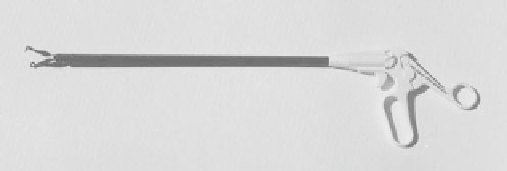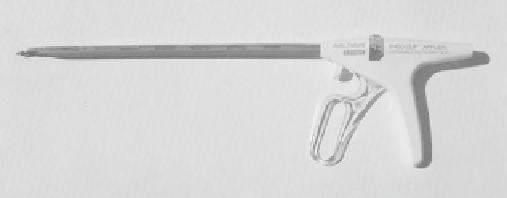Biomedical Engineering Reference
In-Depth Information
Figure 4.3-8 Endoscopic instrument: Autosuture Endo
Babcock graspers.
Figure 4.3-9 Endoscopic instrument: Autosuture Endoclip
applier.
the heart this specialized view is clear. The trans-
esophageal echocardiogram uses the same sound-wave
technology as a regular echocardiogram. The ultrasound
probe emits sound waves of a certain frequency upon the
object to be imaged, and the return wave frequency is
detected by a transducer. The characteristics of the
structure are determined by analyzing the return fre-
quency, and the signals are converted into computerized
images.
Transesophageal echocardiograms are frequently used
to monitor the heart during surgery. Other common uses
include searching for an abnormality in the heart or major
blood vessels that could be responsible for causing
a stroke; looking for infections on the heart valves; and
evaluating the aorta for a tear in its wall.
light, a high-resolution camera that can withstand ster-
ilization, a video processor, a high-resolution monitor(s),
a video recorder, and a printer. Several devices are
employed for exposure and manipulation in laparoscopic
procedures. Trocars are sharp-pointed surgical instruments,
used with a cannula to puncture a body cavity and to
provide intra-abdominal access. A high-flow carbon di-
oxide (CO
2
) insufflator is used to expand the abdominal
cavity, to make internal organs more accessible. Graspers
are devices, generally with two movable and serrated jaws,
that are used to grasp and retract organs (
Figure 4.3-8
).
Figure 4.3-9
shows an endoscopic instrument for apply-
ing clips. Irrigators (or aspirators) are also commonly
used. Instruments used for cutting and coagulation in
laparoscopic procedures include microscissors, electro-
coagulating dissectors and graspers, heater probes, and
lasers.
Cell savers
A cell saver is a device that collects and returns a patient's
blood that otherwise would be lost during a surgical
Heart-lung machines (bypass)
A heart-lung machine (
Figure 4.3-10
) is an apparatus that
does the work both of the heart (i.e., pumps blood) and
the lungs (i.e., oxygenates the blood) during, for example,
open-heart surgery (Galletti andColton, 1995). The basic
function of the machine is to oxygenate the body's venous
supply of blood and then to pump it back into the arterial
system. Blood returning to the heart is diverted through
the machine before returning it to the arterial circulation.
Some of the more important components of these ma-
chines include pumps, oxygenators, temperature regula-
tors, and filters. The heart-lung machine also provides
intracardiac suction, filtration, and temperature control.
Transesophageal echocardiogram
The transesophageal echocardiogram is a device that uti-
lizes ultrasound technology for imaging cardiovascular
anatomy and physiology. This device uses an ultrasound
probe that is inserted in the esophagus and stomach to
image the heart and its associated blood vessels. The
internal perspective avoids the interference from the
anatomy of the chest encountered with external echo-
cardiograms. Because the esophagus is located just behind
Figure 4.3-10 Stockert-Shiley heart-lung machine under
laboratory testing.










